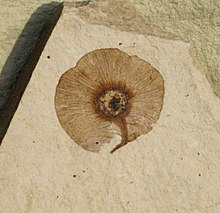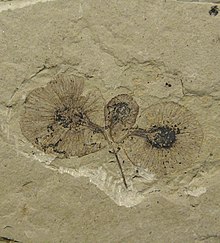Dipteronia brownii
| Dipteronia brownii Temporal range:
| |
|---|---|

| |
| Dipteronia brownii mericarp Klondike Mountain Formation | |
| Scientific classification | |
| Kingdom: | Plantae |
| Clade: | Tracheophytes |
| Clade: | Angiosperms |
| Clade: | Eudicots |
| Clade: | Rosids |
| Order: | Sapindales |
| Family: | Sapindaceae |
| Genus: | Dipteronia |
| Species: | D. brownii
|
| Binomial name | |
| Dipteronia brownii McClain & Manchester, 2001
| |

Klondike Mountain Formation
Dipteronia brownii is an
Distribution and paleoecology
The oldest occurrences for Dipteronia brownii are both Paleogene in age, with fossils found in the Middle Paleocene, 63 to 60 million years ago Fort Union Formation of Wyoming[1] and the Danian Middle-Upper Tsagayan Formation of Northeastern coastal Russia.[2] Migration between the slightly older Russian Far East site and North America was likely facilitated by the Beringian land bridge during the early to middle Paleoene.[3]
In the Early Eocene the species expanded into the Eocene Okanagan Highlands sites of East central British Columbia and north east central Washington. Fossils have been found in the Okanagan highlands formations from the southern most Klondike Mountain Formation to the northern most Driftwood Shales, with occurrences in the Allenby Formation, Tranquille Formation, Chu Chua Formation and Horsefly Shales.[1]
During the Middle Eocene the species appears in the
Ding et al. (2018) posited that the reduction of Dipteronia from the broad North American and wide Asian range seen in D. brownii to the isolated regional
History and classification
Manchester (1999) figured a single Dipteronia mericarp fossil which was at that time identified as being from the Eocene Fushun Formation in Liaoning Province, China. The location was taken from the specimen drawer in the University of California Museum of Paleontology collections where the fossil was stored; however, the fossil itself did not have a label indicating its location.[8] Doubt was later raised regarding the provenance of the fossil, with Manchester being informed that the UCMP formerly housed collections of very similarly colored shale from the Chu Chua Formation near Joseph Creek, British Columbia. The Chu Chua fossils had been transferred to the Geological Survey of Canada collections in the 1970's, but it was possible the Dipteronia specimen was left behind.[1] Palynological analysis of pollen in the specimen matrix was performed in October 2000 in conjunction with the Manchester (2001) research as an attempt to determine the origin site.[1] Based on pollen analysis of Fushun shale, Chu Chua shale and the specimen, much of the palynofloras overlapped. However the palynomorphs Liquidambarpollenites and Ephedripites were only seen in Fushun samples and not the Chu Chua or the mystery sample. Additionally though no other Dipteronia have been identified in Joseph Creek collections, the genus is present at coeval locations elsewhere in the Eocene Okanagan Highlands, leading Manchester (2001) to place the fossil as Joseph Creek, and state Dipteronia was not present in the Fushun Flora.[1]
The North American Dipteronia fossils were reexamined and redescribed by Amy McClain and Steven Manchester, whose 2001 type description for Dipteronia brownii was published in the
Description
Dipteronia brownii fruits were born in
References
- ^ PMID 11454632.
- S2CID 84266950.
- ^ ..
- ^ Manchester, S.R.; McIntosh, W.C. (2007). "Late Eocene silicified fruits and seeds from the John Day Formation near Post, Oregon". PaleoBios. 27 (1): 7–17.
- ^ Brown, R. (1935). "Miocene leaves, fruits, and seeds from Idaho, Oregon, and Washington". Journal of Paleontology. 9: 572–587.
- doi:10.3133/pp154h. 154-H.
- doi:10.3133/b1597.
- JSTOR 2666183.
